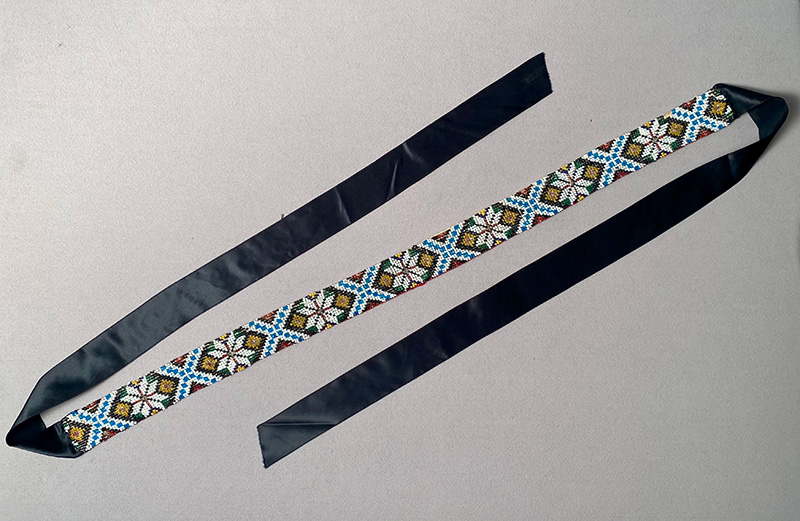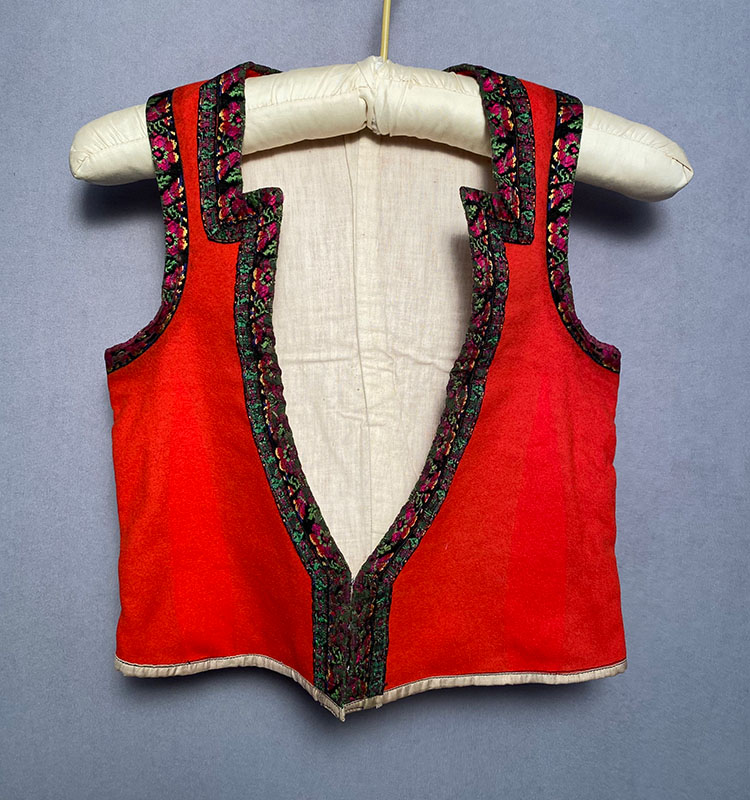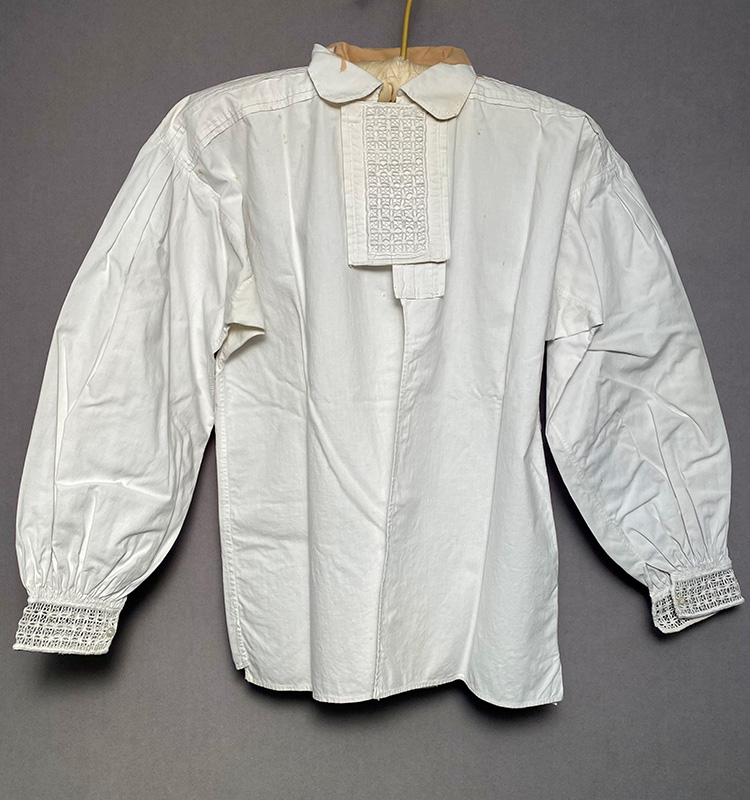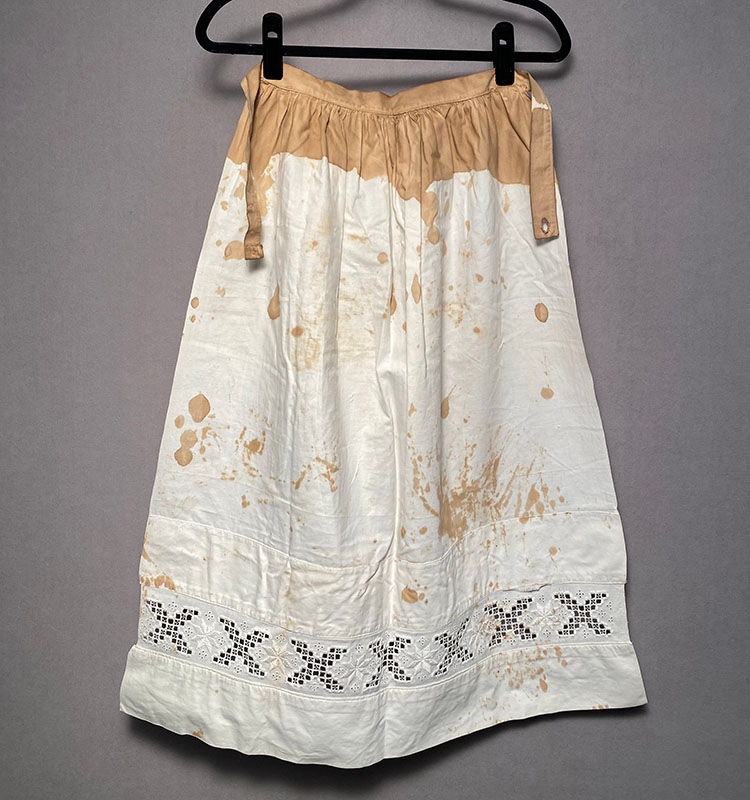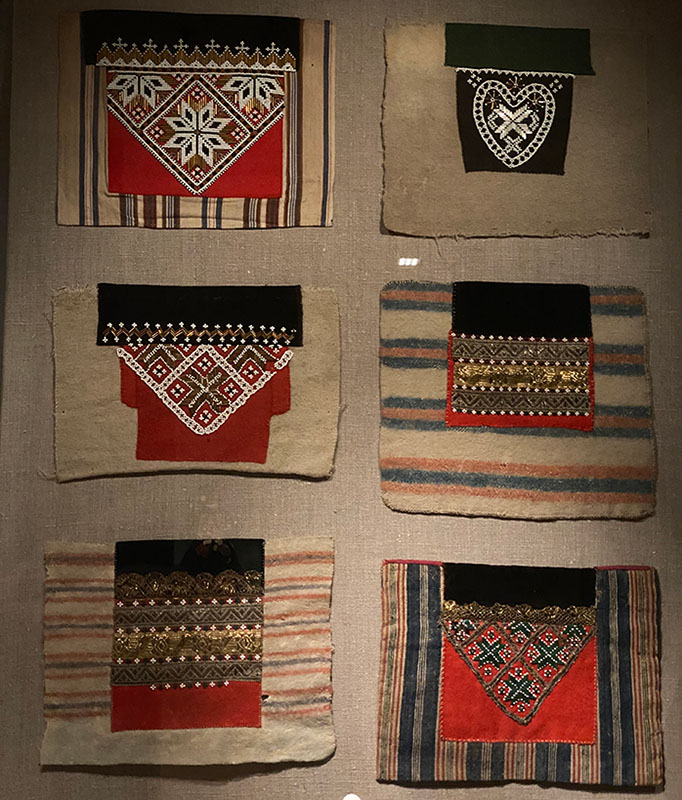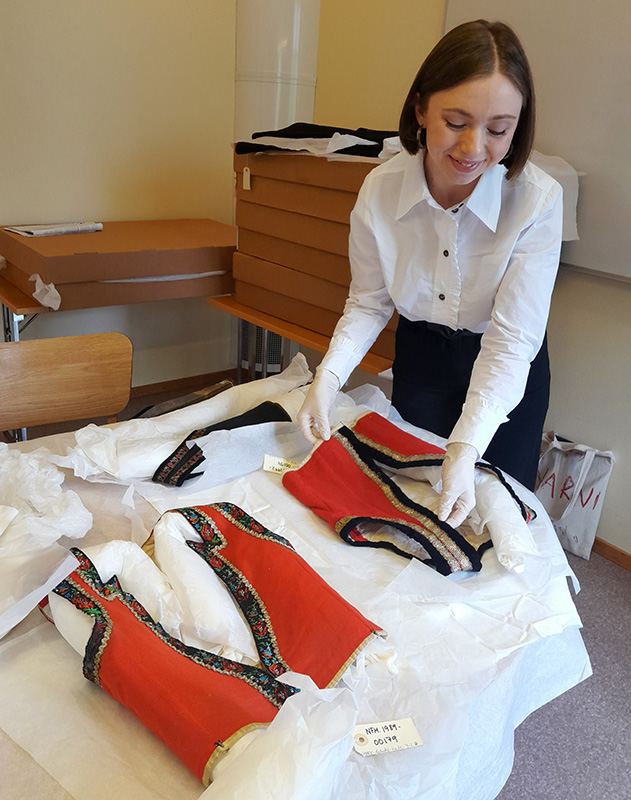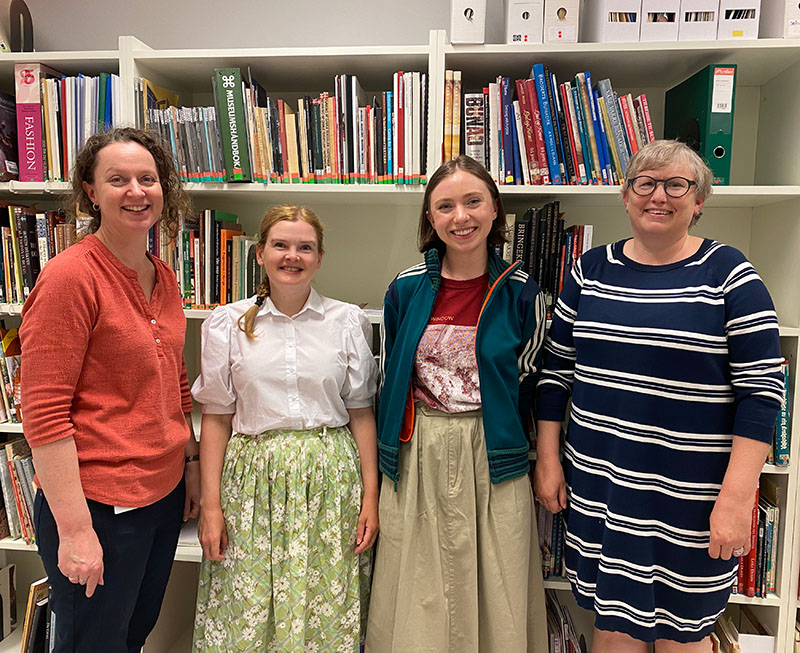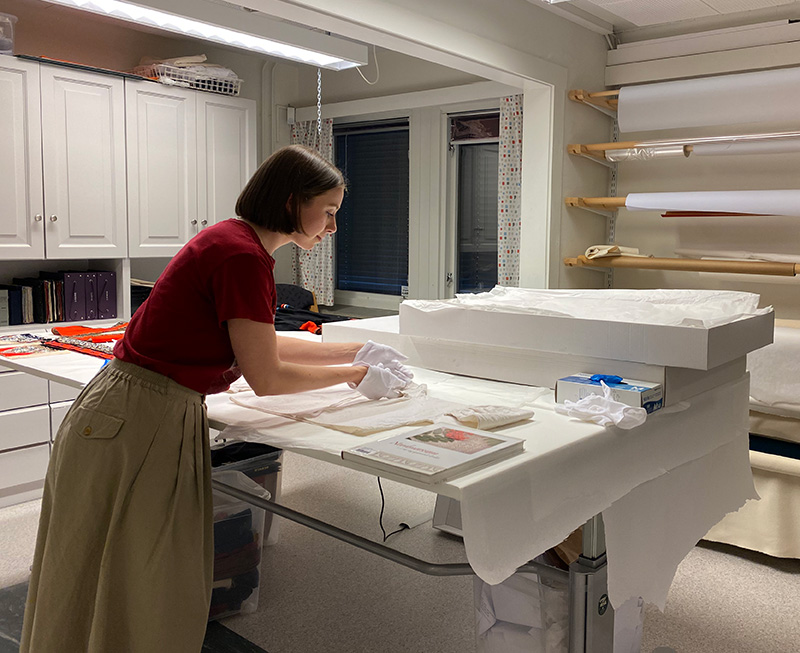Norway’s Bunad: The Evolution of Indigenous Festive Attire
by Cara Green
With the assistance of a Research Grant from the Decorative Arts Trust, I spent three and a half weeks in Norway conducting research on the origins, evolution, and contemporary practices of the bunad, the uniquely Norwegian festive attire inspired by regional folk dress traditions. Inspired by my great-grandmother’s traditional Norwegian bunad (figure 1), this research contributed towards my thesis in the Fashion Institute of Technology’s Masters in Fashion & Textile Studies.
My great-grandmother, Agnes Rugtiv (1893–1985), made her Nasjonaldrakt (National costume), or Hardangerbunad—Norway’s first bunad inspired by the local dress traditions of inner Hardanger—around 1905 while growing up in her hometown of Sandane, a village on the Nordfjorden in Western Norway (figures 2, 3, 4, 5, 6).
Figure 4. Agnes Rugtiv, liv (sleeveless bodice), Sandane, Norway, c. 1905. Wool, cotton. Private collection. Photo by author.
Figure 5. Agnes Rugtiv, skjorte (shirt), Sandane, Norway, c. 1905. Linen. Private collection. Photo by author.
This widely popular National costume evolved out of Norway’s independence movement during the late 19th century, when authentic symbols of Norwegian identity were embraced (figure 7). Surrounding Norway’s independence from Sweden in 1905, the activist and writer Hulda Garborg (1862–1934) made efforts to reform the Nasjonaldrakt and laid the foundation for the contemporary bunad phenomenon. She encouraged Norwegians to return to the local dress traditions of their own ancestral regions as a means to distinguish their specific Norwegian identity from the singular regional influence of the Nasjonaldrakt. Bunads are widely used today for the most important occasions of one’s life, and over 500 locally specific bunad variations have developed since Norway’s independence. As the bunad tradition has evolved, the Hardangerbunad has retained simultaneous regional, national, and international associations as a symbol of personal identity and political action.
During my travels, kind and distinguished individuals at the Nordfjord Folkemuseum in Sandane, Norsk Folkemuseum in Oslo, and Norwegian Institute for Bunad and Folk Costume (NBF) in Fagernes welcomed me with open arms and a wealth of information. The resources and experiences I gathered at these institutions deeply impacted my perspective and knowledge surrounding the unique cultural history and contemporary landscape behind the bunad tradition. Numerous relatives, whom I met for the first time, also provided a deeper understanding of our family history that informed a more specific background behind my primary object of study.
Upon arriving, I encountered three confirmation parties at the hotel with local families all wearing their bunads, which are traditionally presented as a gift to 15-year-olds for their confirmation. Bunads are intended to last a lifetime and to be passed down several generations. Therefore, they are constructed with large seam allowances in order for the clothes to grow with the wearer over time. The construction of early-20th-century Hardangerbunads examined at the three museums confirmed this principle. Although Norwegians will now commonly order a new custom bunad through one of the many specialized stores found all over the country in towns big and small—a process that takes approximately two years—bunads are just as often passed down to and altered for descendants.
Bjørn Sverre Hol Haugen (figure 8), Senior Curator at Norsk Folkemuseum in Oslo and editor of Norsk Bunadleksikon (2006), even told me that girls still wear their ancestor’s Hardanger-inspired Nasjonaldrakt made over 100 years ago. The challenges of managing personal collections of historic bunads is a focal point of my study, as is the consideration of the modern use of historic dress for cultural purposes. Haugen gave me an insightful tour of related exhibitions, including the permanent exhibition “Folk Dress: Festive Dress and Workwear,” curated by Haugen’s predecessor Kari-Anne Pedersen (figure 9). I had the opportunity to meet Pedersen and discuss issues of sustainability and authenticity behind current-day bunad production and practices with her. I also spent time with Norsk Folkemuseum textile conservator Anna Maria Östlund, who hosted me for research appointments and provided a tour of the museum’s collection storage.
Figure 8. Cara Green and Bjørn Sverre Hol Haugen in front of Norwegian woven textile “Crysanthemum,” designed by Frida Hansen, 1900, on view in “TIMESCAPE 1600-1914,” Norsk Folkemuseum, Oslo, Norway. Photo by author, 2023.
At the Nordfjord Folkemuseum in Sandane, I studied comparable Hardangerbunad garment’s in the museum’s collection (figure 10). The conservator Ingrid Berger toured me through the museum’s collection storage and a new permanent exhibition, titled “Attåt,” that addresses the additional skills historically learned by farmers in order to make a living. Dress and textile production are included in this exhibit with a display of locally made 18th- and 19th-century folk dress from Nordfjord alongside the Nordfjord bunad, designed and reconstructed from extant regional folk dress garments in 1928.
At the Norwegian Institute for Bunad and Folk Costume (NBF), Camilla Rossing, Ragni Engstrøm Nilsen, and Solveig Strand (figure 11) allowed me to study the costume and textile collection (figure 12) and offered an in-depth tour of their new exhibition about 12 significant women in bunad history. Rossing, Nilsen, and Strand gifted me their recently published exhibition catalog Kvinner i bunadshistoria (2023), as well as another essential publication Dressing With Purpose (2021), with contributions by Rossing, the director of NBF. She also discussed with me the influence and advisory role of The Bunad and Folk Costume Council today and how it has changed and developed since its founding in 1947. I also attended the opening and festivities for the exhibition “Skakke Folkedrakter” (“Queer Folk Dress”), which tours eight locations in Norway from June 2023 to May 2025 and is developed by Oslo’s National Museum in collaboration with NBF. The exhibition questions the inclusivity of bunads and traditional dress through critical perspectives that subvert preconceived notions of traditional dress belonging to a singular group.
Figure 11. Cara with Ragni Engstrøm Nilsen (left), Solveig Strand (second to left), and Camilla Rossing (right) in the offices and library at the Norwegian Institute for Bunad and Folk Costume, Fagernes, Norway.
Throughout this trip, I witnessed the prevalence of the bunad in Norway and was immersed in the cultural practices and festivities that call for donning this garment. Following my object-based and ethnographic research conducted in Norway in the spring and summer of 2023, I read and translated from Norwegian the numerous books discovered and shared with me that I would not have had access to without traveling to Norway and connecting with the key scholars in this field. I completed my master’s thesis titled “Inheriting a Nasjonaldrakt: The Synchronicity of Memory & Tradition in My Great-Grandmother’s Norwegian Bunad” in the spring of 2024, and the full paper will be published and made publicly accessible on ProQuest. I have already had the opportunity to present this research at international conferences, including those recently hosted by the Fashion Studies Network and The Association of Dress Historians. My research is ongoing as I aim to further develop this project and embrace American-Norwegian heritage and culture through fashion and textiles.
Cara Green is a dress and art historian, researcher, and curator, as well as a personal stylist. She holds a BA in History of Art with a minor in Dance & Performance Studies from the University of California, Berkeley, and recently received her MA in Fashion & Textile Studies: History, Theory, Museum Practice, with a Museum Curation Focus, from the Fashion Institute of Technology.
Update: Cara Green’s thesis is available on ProQuest.
About The Decorative Arts Trust Bulletin
Formerly known as the "blog,” the Bulletin features new research and scholarship, travelogues, book reviews, and museum and gallery exhibitions. The Bulletin complements The Magazine of the Decorative Arts Trust, our biannual members publication.
Click Images to Enlarge
Did you know that clicking on the images in Bulletin posts will allow you to get a closer look? Simply click on an image, and a larger version will open in a pop-up window.










